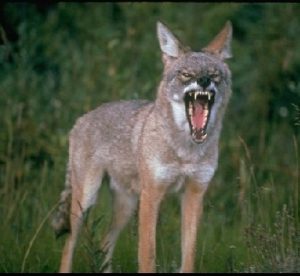Animal Awareness Tip – Coyote (Canis latrans)
Most people probably recall the desperate Wile E. Coyote in his wackiest and exaggerated failed attempts in capturing the Road Runner. Being that it was one of the popular cartoons growing up for our generation, who doesn’t? As a matter of fact, a typical coyote can run up to 40 miles per hour while a roadrunner can only run 17 miles per hour; therefore, even if a coyote comes across such a bird, he/she could successfully outrun them.

Coyotes or Jackals as well as Prairie Wolves are extremely adaptable creatures ranging all the way from Central America to Canada. What also makes them adaptable are their food choices, which include snakes, birds, rodents, deer, insects, fruits, grass, fish, and even carrion. Canis Latrans adjust their hunting methods in accordance to the type of prey. For instance, if a coyote spots a rodent, he/she will act out the characteristics of a feline stalking his/her prey and pouncing on it. However, if a larger size animal, such as a deer, is encountered, a pack of coyotes will work together to capture their meal. On the other hand, if you have spotted a coyote near your property, you might as well rely on experts who offer services such as wildlife removal.
Females are monoestrous, meaning that these lucky creatures undergo their menstrual cycle once per year and usually lie between late January and late March. As soon as a female chooses a partner they temporarily remain with each other for a few years. Coyotes in general contain a quick growth cycle where after their birth they are able to open their eyes, and their ears become erect after 10 days. By around 28 days they emerge from their dens and after around 35 they no longer suckle on their mother’s teats. Both parents take turns regurgitating food for their pups after they are weaned off the mother. They then reach full maturity after 12 months and the males separate from the family while the females stay with the parents to form a pack.
Did You Know? 90% of coyote deaths are caused by either being shot, trapped, or poisoned by humans.







